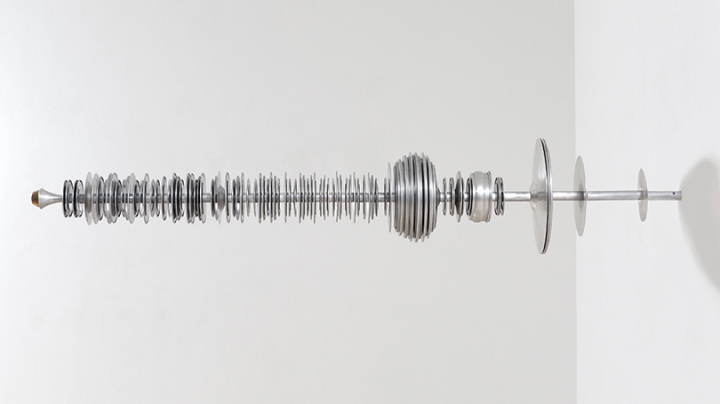This month, sound art comes to Dartmouth through commissions by eight internationally renowned artists.
“Resonant Spaces: Sound Art at Dartmouth” is the first exhibition of sound art presented by the Hood Museum of Art, and, more widely, one of the largest group commissioning projects of sound art to date. Through a diverse set of new, site-specific works located on campus, it offers visitors a glimpse into the highly varied and imaginative world of sound art.
“Resonant Spaces” runs through Dec. 10, with opening events that feature a walking tour of the installations with the artists on Friday, Sept. 22, and a symposium the following day, including artist presentations and a roundtable discussion moderated by Spencer Topel, guest exhibition curator and assistant professor of music in Dartmouth’s Digital Musics Program. Sound artists featured in the exhibition include Terry Adkins, Bill Fontana, Christine Sun Kim, Jacob Kirkegaard, Alvin Lucier, Laura Maes, Jess Rowland, and Julianne Swartz.
On Sept. 28, there will be a special event, Dartmouth Night, when students are invited to attend a reception—and a chance to enjoy the exhibition—from 7 to 9 p.m. For a full schedule of events, go to the Hood website.
“For the eight artists in this show, sound is at the core of their art, as they draw deep inspiration from their personal experiences to create considered and often mesmerizing work that challenges us to hear differently,” says Topel.
As malleable a medium as bronze or oil paint, sound can be recorded from the environment or produced from an object, sculpture, instrument, or living being. It can be responsive to installed spaces or autonomous, continuous or intermittent, loud or soft, imagined or realized. The artists were all invited in part for the compelling ways they explore sound through conceptual, visual, and architectural contexts. Resonant Spaces encourages visitors to experience each site as sound transforms it.
Several emergent threads run through the different works created and selected for the show. These include ideas concerning the relationship between musical instruments and objects, boundaries of visual and sonic perception, Earth both as sound source and as medium, and organization around grids and lattices. More broadly, an undercurrent in their work collectively is attention to and specificity of source, whether it is sampled from the world with microphones or accelerometers, synthesized from circuits, or purely as a product of the sonic imagination as both touch and sound. Each artist strives to reveal or illustrate ideas through objects and architectures in strikingly different, yet profound ways.
Visitors to the Hood Downtown exhibition space will experience the work of Jess Rowland and the late Terry Adkins, as well as an overview of the complete exhibition. Both Rowland’s and Adkins’ work is rooted in the structure of music and invites the viewer to literally or imaginatively “perform” each work. Interactivity continues in Julianne Swartz’s Transfer.(objects), making the visitor complicit in the production of sound in the sound-restrictive environment of the library to produce a private listening experience that echoes that of reading.
In contrast, Bill Fontana turns Dartmouth’s Class of 1978 Life Sciences Center into an instrument performed by the machines and people inhabiting it in concert with the ambient sounds outside of the building. Installed on and around the steel structure in front of the stairway windows at the south entrance, Fontana’s interactive sound sculpture responds and adapts over time.
Earth plays a significant role in works created by Alvin Lucier and Jacob Kirkegaard. Lucier creates an underground, and therefore invisible, piece for the Bema, an outdoor amphitheater, drawing the visitor to experience the fusion of the physical space with the sounds created from buried sound sources. Kirkegaard considers Earth on a geological level, by mapping subterranean and surface recordings of unique rock formations in Utah and Arizona onto the multistory atrium of the Fairchild Physical Sciences Center, offering the architecture a new sonic identity rooted in nature.
Connections to the natural world continue in Laura Maes’ work, with grids of solar panels that translate sunlight into a cluster of clicks on the ceiling of the entryway to Cummings Hall at Thayer School of Engineering. As light patterns change on the facade of the building, so does the sonic mapping inside the building, bringing the visitor into a liminal space between the light and acoustic energy. The grid is likewise a structuring feature of Christine Sun Kim’s The Grid of Prefixed Acousmatics, which uses earth (clay) as a way to fix the concepts of sound in the visual world—a kind of visual dictionary of specific sonic contexts.
Together, this work provides a snapshot of eight multigenerational contemporary artists who place sound at the center of their practices. Their work is as diverse as the ideas embedded within it, and each artist challenges us to perceive sound and the spaces we inhabit differently.

